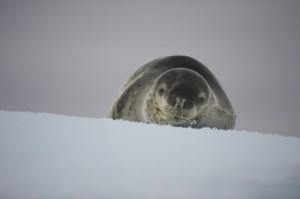Has spots, but not a leopard.
- Leopard seals are the second largest seal species in Antarctica, ranging from 2.4 – 3.5 metres (8.4 – 11.7 feet) long and 200 to 600 kilograms (440 to 1,300 pounds) in weight.
- Leopard seals are most common in the Southern Hemisphere, especially on the coast of Antarctica.
- Leopard seals have a typical lifespan of 26 years or more.
- Leopard seals have only a couple of predators – large sharks and killer whales (orcas).
- Leopard seals have dark grey coloured backs, light grey coloured underside and black spotted, white skin necks.

Leopard Seal
Image courtesy of National Geographic
- Female leopard seals are generally larger than males.
- Leopard seals don’t make many sounds, but sometimes makes grunting and growling noises.
- Leopard seals don’t normally live in groups, except to mate.
- A leopard seals diet includes krill, fish, penguins and sometimes other seals.
- Leopard seals rarely attack people, even though they are considered quite dangerous, and the first recorded fatality was in 2003 in Antarctica.




